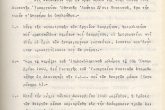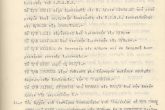Shipwreck of destroyer Thiela-Torpedo ship Aigli
Destroyer Thiela
The ship called “Thiela” was constructed in England at the Yarrow shipyard after being ordered by the Greek Government in 1906. It was one of the four
destroyers constructed in England from 1905 until 1907 for the Greek Royal Navy. The other three destroyers were called “Sfendoni”, “Logxi” and
“Nafkratusa”. The ship participated in the Balkan Wars in 1912-1913, in the World War I and in the Asia Minor operation. Between 1926 and 1928,
the ship was totally renovated at the dock yard of Salamia island and then participated in the Greek-Italian war in 1940-1941 as a torpedo boat in
many patrols and convoys. During the Greek-Italian war in 1940-1941, “Thiela” was part of the Torpedo boat Division A of the Royal Navy and it also participated in patrols and
convoys with the destroyers “Sfendoni”, “Niki” and “Aspis” at the region of Cyclades, North Aegean Sea, Thermaikos Bay, Patraikos Bay and South
Peloponissos. During mid April in 1941 and after the beginning of the ferocious German attack to Greece, in April 6th, “Thiela” was moved to Vuliagmeni
region along with the torpedo boats of the Greek Royal Navy “Aigli”, “Arethusa”, “Alkioni” and “Doris” from the Nautical Defense Region 1 in Patra in
order to realize patrols at Saronikos and south Evoikos Bay. The decision of making Vuliagmeni the anchorage of these torpedo boats was taken in order
to avoid their block in the dock yard due to the continuous dropping of magnetic mines by the German air force in the region of Saronikos Bay.
In April 21st and while “Thiela” was at its anchorage in Vuliagmeni, under the Lieutenant Commander Mr. P. Damiralis, it was ferociously attacked by six
German bombing aircrafts in diving missile (Junkers 87 Stuka), that caused fractures of a diameter of 5-10cm to its bottom, water line and freeboard as
they dropped beams of bombs. During the attack, the machine guns of the ship were keeping attacking to the German air crafts which injured 6 of its parts.
After the attack and the irreversible damages caused to the ship, “Thiela” was abandoned. According to the report of the Lieutenant Commander Mr.
Damiralis in May 19th 1941 to the Ministry of Defense (see The war diary, Volume 6, p. 1-4, Navy History Service), the consequences of the air attack
were the below:
– Serious water leaks at all parts of the ship
– Small fires at the spaces of accommodation and at the deck
– Explosion of the ammunition box located at the deck
– Destruction of the stern web
– Displacement and destruction of the engine refrigerator base
– Several small damages at all parts and floors of the ship
The general condition of “Thiela” and its incapacity to continue its operation was the reason why they left it dragged by the wind into the deep sea.
Then, at 21.00pm of the same day (21.04.1941), the captain of the torpedo ship Mr. Damiralis was commanded by the Commander of the torpedo ship fleet
Mr. Theofanidis to sink “Thiela” at Vuliagmeni and this is what finally happened the night of April 21st to 22nd 1941.
“Thiela” had the below technical characteristics:
Total length: 67m
Maximum width: 6,7m
Draught: 1,8m
Displacement: 355t.
Speed: 30 knots and after 1940 25 knots
Crew: 70 people
Impulse system: Engine of 6500 hp
Armour (1906): 2 fast shooting weapons of 76 mm (Hotchkins), 4 fast shooting weapons of 57 mm (Hotchkins) and 2 torpedo tubes of 450mm
Armour: (1928): 2 firearms of 88mm/ 30 (Krupp), 1 firearm 40mm, 2 torpedo tubes of 450mm (Schwarzkopf)
Aigli
The ship “Aigli” was ordered by the Greek Government to the famous Vulcan shipyard which was located in the city called Szczecin, that those days was
part of Germany, today is part of Poland. It was one of the six torpedo ships that Vulcan constructed for the Greek Royal Navy. The other five were
“Alkioni”, “Arethusa”, “Dafni”, “Doris” and “Thetis”. After its construction and delivery, “Aigli” travelled to Greece in May 1914. In 1916, upon the
block of Athens and Piraeus by the Entente forces, “Aigli” was prescribed by the French Navy and it was used in the World War I with French crew. After
Greece participating in the war by the side of Entente, the ship was returned to the Greek Royal Navy in 1917 and it was then part of the convoys in
Aegean Sea until the end of the war.
Upon the beginning of the Asia Minor operation, “Aegli” participated in several operations and after its bitter end it was one of the first ships that
participated in the evacuation of the Greek population in Asia Minor. During the Greek-Italian War in 1940-1941, “Aigli” was part of the Torpedo ship
Division C of the Royal Navy and it was doing patrols as well as it was part of convoys at the region of Cyclades, south and north Evoikos Bay,
Thermaikos and Saronikos Bay. Immediately after the beginning of the war by the Nazi Germany against Greece, “Aigli” along with the torpedo ships
“Thiela” and “Arethusa”, stayed at Vuliagmeni that was their anchorage until its sinking.
In April 20th the ship, under the captain I. Naksakis, was attacked with fireguns by aircrafts of the German Military Air Force and as a result fractures
were created in the ship that weas partially recovered but still it was not totally fixed. As the ship captain Mr. I. Naksakis mentions in his report in
27.5.1941 (see The war diary, Volume 7, p. 177, Navy History Service) the ship due to bombing caused at Saronikos Bay during the last days it was attacked
and damages were caused in many parts of the ship. Mainly the two big fractures that were caused in the left side of it, even though they were fixed,
it was not sure if the ship could make any long travel anymore.
In April 22nd, “Aigli” was ordered to travel to North Evoikos bay in order for the patrol of Stroggyli Island. However, the continuous and unstoppable
attacks of the German air crafts made the ship to return back to Vuliagmeni where it anchored. During its stay over there, the crew was ordered to
abandon the ship and stay at the opposite coast. As it is mentioned in the “Fact Report” of June 3rd 1941 of the Commander of the torpedo ship fleet Mr. Theofanidis
(see The war diary, Volume 7, p.135-144, Navy History Service), the crews of the Greek torpedo ships and especially that of “Aigli” due to the continuous and ferocious air attacks and information concerning the sinking of the ship and the firing of the crew of the dock yard and of other departments, the moral of the crew was very
bad and it was very difficult to cheer them up with advices and this is why finally the crew went to the opposite coast. In order not for the ship to be
taken by the enemy, it was decided to sink it in April 24th.
“Aigli” had the below technical characteristics:
Total length: 45m
Maximum width: 4,8m
Draught: 1,2m
Displacement: 145t.
Speed: 21 knots and in 1940 19 knots
Impulse system: Engine of 2600 hp
Armour (1906): 1 firearm of 37mm, 3 torpedo tubes (Schwarzkopf) of 450mm
Historical and diving aspect
The two ships stayed in the sea bottom immersed the one next to the other, south of Zostir cape (Vuliagmeni) in a depth of almost 50m during the whole war.
After the war, the wrecks of the two torpedo ships were sold at an auction of the Organization of Wreck Hoisting and they were partially fixed in 1950’s.
Today, there are still in the sea bottom parts and pieces of those two ships, spread at the area where, in April 1941, was the anchorage of the ships in
Vuliagmeni. It is impossible of someone to realize nowadays which part belongs to which ship. “Thiela” and “Aigli” were tied up with the same faith in
April 1941 and they can be approached only as a united historical and diving unit.
DG
Sources
The War Diary 1940-1944, Volumes 5,6,7, Navy History Service, Department of Historical Archives
Fokas, Demetrios: (1953). Report concerning the actions of the Royal Navy during the war in 1940-1944, Volume A: From the pre-war period until the
conquest of Greece (27 April 1941), Edition of Historical Service of Royal Navy
Kavadias Epaminondas: (1950) The Navy War in 1940 as I lived it, Athens
Oikonomou, D.: (1947) The records of the Royal Navy from April 10th until April 27th 1941, Editions N. Alikiotis, Athens
Sakelariou Aleksandros: Memoirs – An admiral remembers, Volume A and B, Editions Giota Sigma, Athens
Paizis – Paradelis Konstantinos: (1980) The ships of the Greek Navy 1830-1979, Editions GEN, Athens
Dounis Christos: (2001) The Wrecks in Greek Seas 1900-1950, Volume A, Editions Finatec, Athens
http://en.wikipedia.org/wiki/List_of_shipwrecks_in_April_1941






















